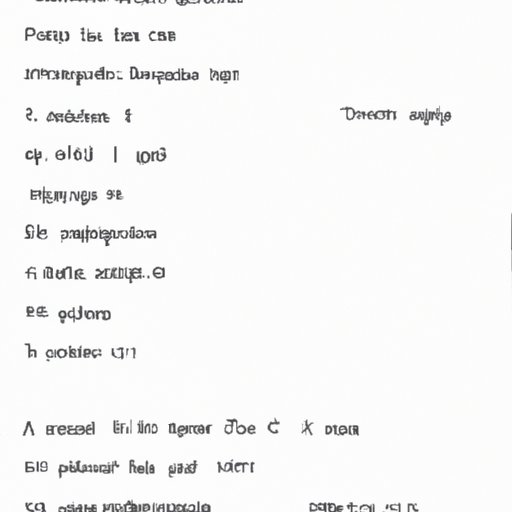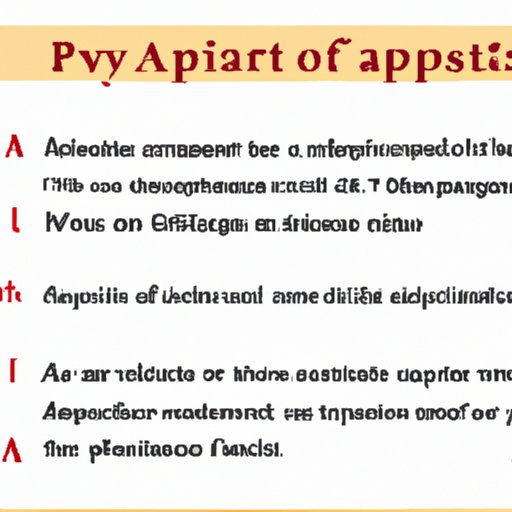
I. An Overview of APA Writing Style
APA writing style, or American Psychological Association (APA) style, is a set of rules and guidelines for formatting papers written for the social sciences. It is a widely accepted academic writing style used by scholars and researchers in the fields of psychology, education, business, and other related disciplines. The goal of this style is to ensure that all sources are cited properly and consistently throughout the paper.
A. Definition of APA Writing Style
APA writing style is a standardized format developed by the American Psychological Association (APA). This style is used to provide structure and organization to academic papers, such as research papers, essays, and dissertations. It is designed to make reading and understanding these documents easier. This style contains specific rules for formatting text, citing sources, creating headings and subheadings, and constructing a reference list.
B. History and Development of APA Writing Style
APA writing style has evolved over time to become the standard for academic writing in the social sciences. It was first developed in 1929 by the American Psychological Association as a way to standardize the language and format of academic papers in the field of psychology. Since then, it has been adopted by other disciplines and is now widely used in all areas of academia.
II. A Guide to Understanding the Elements of APA Writing Style
APA writing style consists of several components that must be followed when formatting a paper. These components include in-text citations, headings and subheadings, title page, abstract, body of the paper, and reference list.
A. In-Text Citations
In-text citations are brief references to sources that are included within the body of the paper. These citations consist of the author’s last name and the year of publication. For example: (Smith, 2020). In-text citations should be used whenever you use information from another source in your paper.
B. Headings and Subheadings
Headings and subheadings are used to organize the paper into sections. Headings are used to divide the paper into main topics while subheadings are used to further break down the topics into smaller ideas. Headings should be formatted according to the APA guidelines, which includes using bold font and capitalizing the first letter of each word.
C. Title Page
The title page is the first page of the paper and should include the title of the paper, the author’s name, and the institutional affiliation. It should also include the date the paper was written and any acknowledgments or disclaimers.
D. Abstract
An abstract is a short summary of the paper that should be included after the title page. It should be no more than 250 words and should provide an overview of the main points of the paper. It should also include the purpose, methods, results, and conclusions of the paper.
E. Body of the Paper
The body of the paper should contain the main content of the paper. It should include an introduction, discussion of the topic, and a conclusion. All sources used in the paper should be cited properly throughout the body of the paper.
F. Reference List
The reference list is a list of all sources used in the paper. It should include the full citation for each source, including the author’s name, year of publication, and publisher. Sources should be listed in alphabetical order.
III. Tips for Utilizing APA Writing Style in Your Academic Writing
Using APA writing style in your academic writing can help to ensure that your paper is properly formatted and that all sources are cited correctly. Here are some tips for utilizing APA writing style in your academic writing:
A. Understand the Basics of APA Writing Style
Before you begin writing, it is important to understand the basics of APA writing style. Familiarize yourself with the elements of APA writing style, such as in-text citations, headings and subheadings, title page, abstract, body of the paper, and reference list. This will help you to ensure that your paper is properly formatted.
B. Use Consistent Formatting and Punctuation
When using APA writing style, it is important to use consistent formatting and punctuation throughout your paper. This includes using the same font and font size, indenting paragraphs, and using the correct punctuation marks. This will help to make your paper look professional and organized.
C. Ensure that all Sources are Cited Properly
It is important to make sure that all sources used in your paper are cited properly. This includes providing both in-text citations and a reference list. Make sure that all sources are listed in the correct format and that all information is accurate.
D. Double Check to Make Sure Everything is Accurate
Before submitting your paper, it is important to double check to make sure that everything is accurate. Read through your paper to make sure that there are no errors and that all sources are cited correctly. This will help to ensure that your paper meets the requirements of APA writing style.

IV. How to Apply APA Writing Style in Different Writing Contexts
APA writing style can be applied to a variety of writing contexts. Here are some tips for applying APA writing style in different writing contexts:
A. Writing for Social Sciences
APA writing style is most commonly used when writing for social sciences. When writing for social sciences, be sure to follow the specific guidelines outlined in the APA Publication Manual. This includes formatting the paper correctly, using in-text citations, and providing a reference list.
B. Writing for Natural Sciences
APA writing style can also be used when writing for natural sciences. However, it is important to note that the formatting and citation guidelines may differ slightly from those outlined in the APA Publication Manual. Be sure to consult the appropriate style guide when writing for natural sciences.
C. Writing for Business
APA writing style can also be used when writing for business. However, it is important to note that the formatting and citation guidelines may differ slightly from those outlined in the APA Publication Manual. Be sure to consult the appropriate style guide when writing for business.

V. Advantages and Disadvantages of Using APA Writing Style
Using APA writing style has both advantages and disadvantages. Here are some of the advantages and disadvantages of using APA writing style:
A. Advantages
One of the advantages of using APA writing style is that it provides structure and organization to academic papers. It also helps to ensure that all sources are cited properly and consistently throughout the paper. Additionally, it makes reading and understanding academic papers easier.
B. Disadvantages
One of the disadvantages of using APA writing style is that it can be difficult to learn and understand. It is also time consuming to format a paper according to the rules of APA writing style. Additionally, it may not always be applicable to all types of academic writing.
(Note: Is this article not meeting your expectations? Do you have knowledge or insights to share? Unlock new opportunities and expand your reach by joining our authors team. Click Registration to join us and share your expertise with our readers.)
